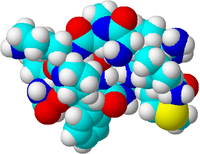
Photo from wikipedia
Two histamine receptor subtypes (HR), namely H1R and H4R, are involved in the transmission of histamine-induced itch as key components. Although exact downstream signaling mechanisms are still elusive, transient receptor… Click to show full abstract
Two histamine receptor subtypes (HR), namely H1R and H4R, are involved in the transmission of histamine-induced itch as key components. Although exact downstream signaling mechanisms are still elusive, transient receptor potential (TRP) ion channels play important roles in the sensation of histaminergic and non-histaminergic itch. The aim of this study was to investigate the involvement of TRPV1 and TRPA1 channels in the transmission of histaminergic itch. The potential of TRPV1 and TRPA1 inhibitors to modulate H1R- and H4R-induced signal transmission was tested in a scratching assay in mice in vivo as well as via Ca2+ imaging of murine sensory dorsal root ganglia (DRG) neurons in vitro. TRPV1 inhibition led to a reduction of H1R- and H4R- induced itch, whereas TRPA1 inhibition reduced H4R- but not H1R-induced itch. TRPV1 and TRPA1 inhibition resulted in a reduced Ca2+ influx into sensory neurons in vitro. In conclusion, these results indicate that both channels, TRPV1 and TRPA1, are involved in the transmission of histamine-induced pruritus.
Journal Title: Biomolecules
Year Published: 2021
Link to full text (if available)
Share on Social Media: Sign Up to like & get
recommendations!